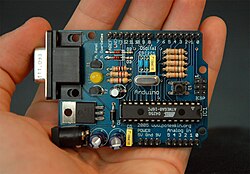| | |
 | |
| Developer | arduino.cc |
|---|---|
| Manufacturer | Many |
| Type | Single-board microcontroller [1] |
| Availability | Uno R4 webpage |
| Operating system | None, with bootloader (default), FreeRTOS |
| CPU |
|
| Memory | SRAM |
| Storage | Flash, EEPROM |
| Website | arduino.cc |
The Arduino Uno is a series of open-source microcontroller board based on a diverse range of microcontrollers (MCU). It was initially developed and released by the Arduino company in 2010. [2] [3] The microcontroller board is equipped with sets of digital and analog input/output (I/O) pins that may be interfaced to various expansion boards (shields) and other circuits. [1] The board has 14 digital I/O pins (six capable of PWM output), 6 analog I/O pins, and is programmable with the Arduino IDE (Integrated Development Environment), via a type B USB cable. [4] It can be powered by a USB cable or a barrel connector that accepts voltages between 7 and 20 volts, such as a rectangular 9-volt battery. It has the same microcontroller as the Arduino Nano board, and the same headers as the Leonardo board. [5] [6] The hardware reference design is distributed under a Creative Commons Attribution Share-Alike 2.5 license and is available on the Arduino website. Layout and production files for some versions of the hardware are also available.
Contents
- History
- Technical specifications
- Uno R1 to R3
- Uno R4
- Uno Q
- Headers
- General pin functions
- Special pin functions
- Communication
- Automatic (software) reset
- Arduino board comparison
- Gallery
- See also
- References
- Further reading
- External links
The word "uno" means "one" in Italian and was chosen to mark a major redesign of the Arduino hardware and software. [7] The Uno board was the successor of the Duemilanove release and was the 9th version in a series of USB-based Arduino boards. [8] Version 1.0 of the Arduino IDE for the Arduino Uno board has now evolved to newer releases. [4] The ATmega328 on the board comes preprogrammed with a bootloader that allows uploading new code to it without the use of an external hardware programmer. [3]
While the Uno communicates using the original STK500 protocol, [1] it differs from all preceding boards in that it does not use a FTDI USB-to-UART serial chip. Instead, it uses the Atmega16U2 (Atmega8U2 up to version R2) programmed as a USB-to-serial converter. [9]







